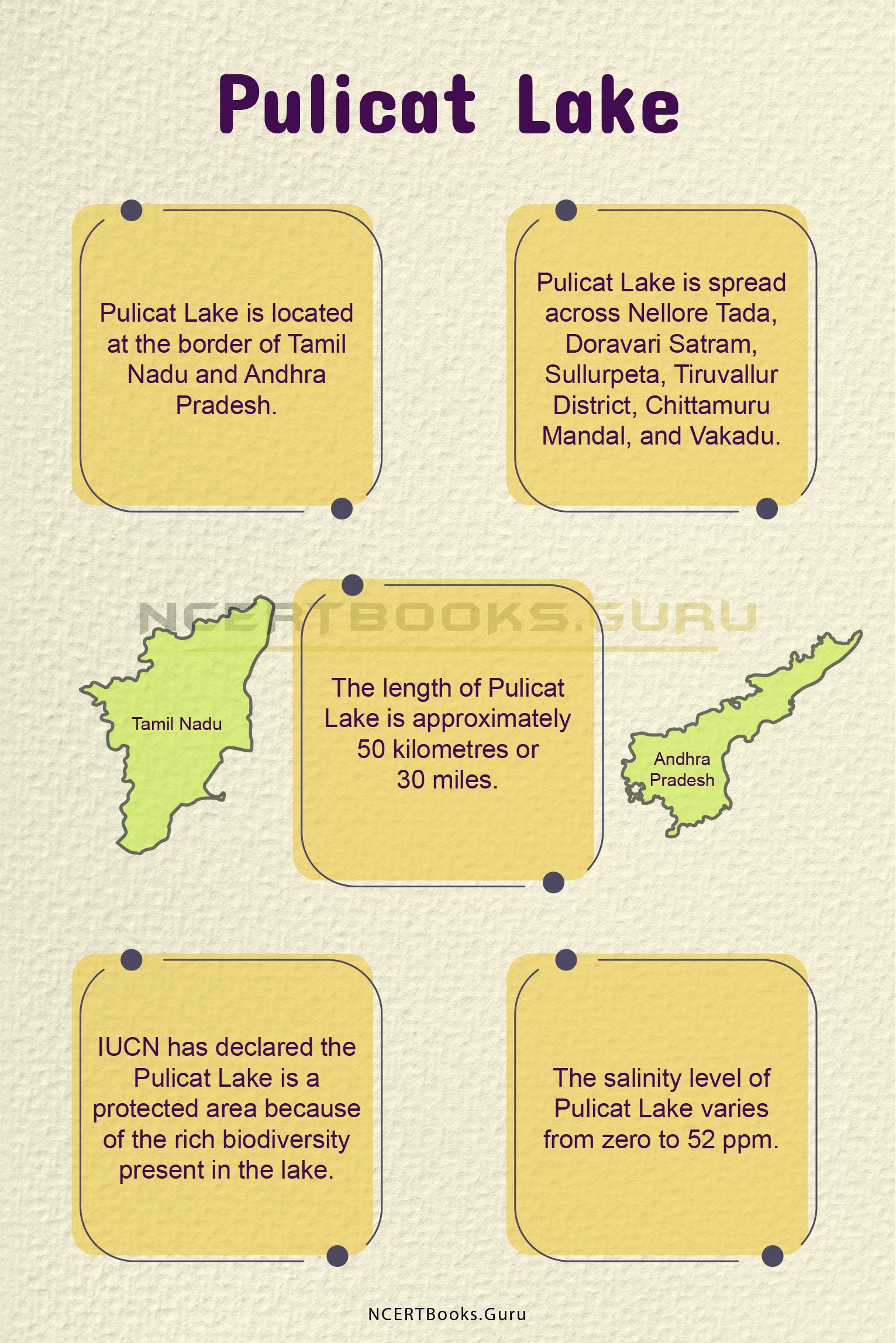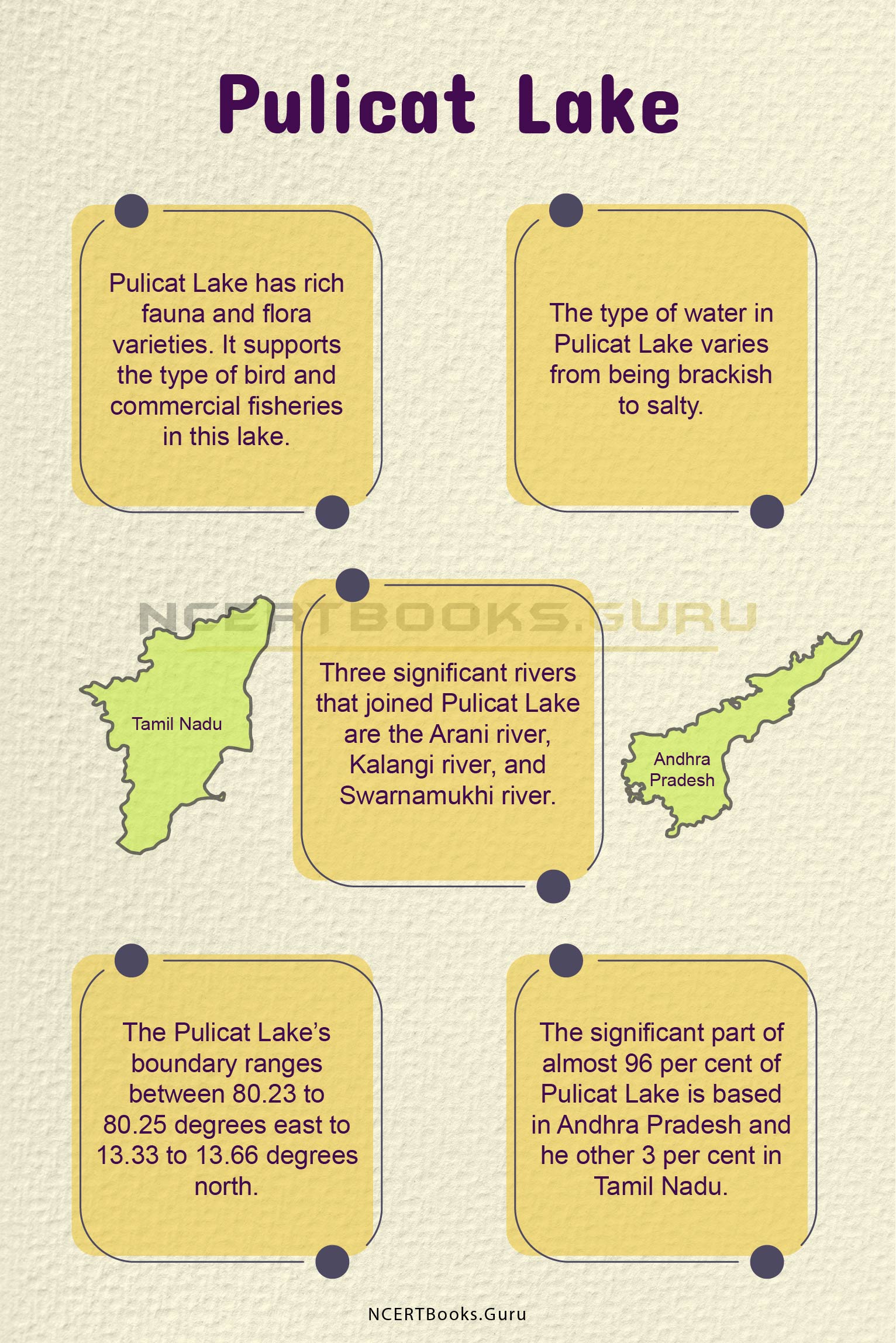Pulicat Lake is also called the Pulicat Bird Sanctuary. It is one of the famous tourist hotspots in India. Pulicat Lake is located at the border of Tamil Nadu and Andhra Pradesh. Pulicat Lake covers approximately 759 square kilometres.
Pulicat Lake is spread across Nellore Tada, Doravari Satram, Sullurpeta, Tiruvallur District, Chittamuru Mandal, and Vakadu. This lake offers the beautiful sight of fascinating birds. Pulicat Lake is a famous bird sanctuary in Tamil Nadu.
Pulicat Lake Details
| States Covered | Andhra Pradesh and Tamil Nadu |
| Length | Approximately 50 kilometres or 30 miles |
| Width | 0.2 to 17.5 kilometres |
| Salinity Level | Zero to 52 ppm |
| Major Inflows | Arani river, Kalangi river, and Swarnamukhi river |
| Colour of Water | Blue, green, and red |
| Reason for pollution | Sewage, agricultural chemicals, pesticides, and industrial effluents |
About Pulicat Lake
Pulicat Lake is a saltwater lagoon. It extends from the southeast of Andhra Pradesh to Tamil Nadu. The length of this lake is approximately 50 kilometres or 30 miles. Pulicat Lake is located on the sandy plains of Andhra Pradesh. Pulicat Lake yields prawns and salt.
Pulicat Lake is separated from the Bay of Bengal by narrow Sriharikota. Pulicat Lake mixes to the sea at the south end of the island. This lake has the membership of the international network Living Lakes. CReNIEO represents Pulicat Lake. It is the second-largest brackish-water ecosystem in the eastern part of India. It is a shallow lake.
The average depth of Pulicat Lake is one meter. This lake is drained by many minor inflows and three large inflows. Pulicat is a city with historical significance. It is also an important port for trades in Europe and the far east. Pulicat Lake is home to millions of birds, mammals, and reptiles. A wide variety of fishes live in Pulicat Lake.
Pulicat Lake History
An anonymous mariner listed Pulicat Lake in one of his books. S/he mentioned it as one of the three ports on the east of India. In the 13th century, Arabs started migrating to the shores of Pulicat Lake after they were banished from Mecca as they refused to pay tributes to the new caliph.
The houses of these Arabian Muslims are still found near Pulicat Lake. Portuguese and the Greeks made their colonies in this lake. The Dutch got to know about this lake when their ships got stuck on the shores of a village situated on the opposite side of the lake. It was known as Pallaicatta at the time of Dutch colonisation.
Pulicat Lake is fed by the Arani river and Kalangi river. The Buckingham Canal is also part of this lake on the western side. This lake exchanges water with the Bay of Bengal through an inlet channel at Sriharikota. Pulicat Lake acts as a buffer and stores the flood water till the floodwater gets discharged to the sea during the monsoon period. The basins of this lake are situated in Tamil Nadu and Andhra Pradesh. However, most of its part is located in Andhra Pradesh.
Pulicat Lake Map
The Pulicat Lake’s boundary ranges between 80.23 to 80.25 degrees east to 13.33 to 13.66 degrees north. The significant part of almost 96 per cent of the lake is based on Andhra Pradesh and the other 3 per cent in Tamil Nadu. Approximately 450 square kilometres area of this lake is in high tide, and 250 square kilometres area of this lake is in low tide.
The length of Pulicat Lake is almost 60 kilometres. Its width varies from 0.2 to 17.5 kilometres. The tropical monsoon dominates the climate of Pulicat Lake. The temperature of the air in this area ranges from 15 to 45 degrees C.
The type of water in this lake varies from being brackish to salty. Three significant rivers that joined Pulicat Lake are the Arani river, Kalangi river, and Swarnamukhi river. The Pulicat Lake, with its outlet to the sea, is situated in Andhra Pradesh. The salinity of the water of this river affects the biodiversity, fisheries, and the primary production in the lake.
Have a look at the List of Important Lakes in India that you need to know for your competitive exams to score well.
Pulicat Lake System
This lake is located sixty kilometres north of Chennai. The salinity level of this lake varies from zero to 52 ppm. It stays at zero levels during the monsoon and 52 ppm in pre and post-monsoon seasons.
This lake is located in Andhra Pradesh and Tamil Nadu. The lake is famous because of its bird sanctuary. The water in this lake is shrinking rapidly. The depth of the water has reduced from 1.5 metres to 1 meter.
Pulicat Lake has rich fauna and flora varieties. It supports the type of bird and commercial fisheries in this lake. IUCN has declared the Pulicat Lake as a protected area because of the rich biodiversity present in the lake.
Pulicat Lake Pollution
Pulicat Lake has also become the prey of pollution. The significant sources of pollution in this lake are sewage, agricultural chemicals, pesticides, and industrial effluents. Waste materials flow to the Pulicat Lake from Kalangi and Arani river. Pulicat Lake has a wide variety of fishes. Many significant commercial fishery activities happen in this lake.
As a result, the wastes of commercial fisheries pollute the water of the Pulicat Lake. The farming of shrimp in large part of this lake has affected the bird sanctuary of this lake. It has affected the lives of twenty thousand farmers and thirty thousand fishermen engaged in fisheries. However, the unethical fish production in the lake has affected aquatic life.
The petrochemical park in this area also pollutes Pulicat Lake. The closure of the sea mouth of the lake is also a significant threat to the biodiversity of this lake. This stops the migration and remigration of fauna and fish. As a result, it creates terrible effects on the food network, mainly migratory birds. However, the Indian government is concerned about the safety of this lake and has taken various steps to protect the natural aspect of Pulicat Lake.
Pulicat Lake Importance
Pulicat Lake is mainly essential for its biodiversity. Millions of migratory birds, fauna, and fishes come to Pulicat Lake. It is an important wetland of India. Many migratory birds like the flamingo, storks, gulls, herons, pelicans, and many others stay in the area of Pulicat Lake.
This lake has a rich diversity of flora and fauna. This lake has a famous bird sanctuary. Numerous microscopic plants grow in this lake which creates nutrients for aquatic life. Every year, the ‘Flamingo Festival’ is celebrated in Pulicat Lake. Eco-tourism had also built up in the Pulicat Lake.

Short Essay on Pulicat Lake
Pulicat Lake is a saltwater lagoon. It extends from the southeast of Andhra Pradesh to Tamil Nadu. The length of this lake is approximately 50 kilometres or 30 miles. Pulicat Lake is located on the sandy plains of Andhra Pradesh. CReNIEO represents Pulicat Lake.
It is the second-largest brackish-water ecosystem in the eastern part of India. It is a shallow lake. The average depth of Pulicat Lake is one metre. This lake is drained by many minor inflows and three large inflows. Pulicat is a city with historical significance. The Pulicat Lake’s boundary ranges between 80.23 to 80.25 degrees east to 13.33 to 13.66 degrees north.
The significant part of almost 96 per cent of the lake is based on Andhra Pradesh and the other 3 per cent in Tamil Nadu. Pulicat Lake is mainly essential for its biodiversity. Millions of migratory birds, fauna, and fishes come to Pulicat Lake. It is an important wetland of India. Pulicat Lake has also become the prey of pollution.
The significant sources of pollution in this lake are sewage, agricultural chemicals, pesticides, and industrial effluents. Waste materials flow to the Pulicat Lake from Kalangi and Arani river. Pulicat Lake has a wide variety of fishes. Many significant commercial fishery activities happen in this lake. As a result, the wastes of commercial fisheries pollute the water of the Pulicat Lake.
Ten Lines on Pulicat Lake
- Pulicat Lake is located at the border of Tamil Nadu and Andhra Pradesh.
- Pulicat Lake is spread across Nellore Tada, Doravari Satram, Sullurpeta, Tiruvallur District, Chittamuru Mandal, and Vakadu.
- The length of Pulicat Lake is approximately 50 kilometres or 30 miles.
- IUCN has declared the Pulicat Lake is a protected area because of the rich biodiversity present in the lake.
- The salinity level of Pulicat Lake varies from zero to 52 ppm.
- Pulicat Lake has rich fauna and flora varieties. It supports the type of bird and commercial fisheries in this lake.
- The type of water in Pulicat Lake varies from being brackish to salty.
- Three significant rivers that joined Pulicat Lake are the Arani river, Kalangi river, and Swarnamukhi river.
- The Pulicat Lake’s boundary ranges between 80.23 to 80.25 degrees east to 13.33 to 13.66 degrees north.
- A significant part of almost 96 per cent of Pulicat Lake is based in Andhra Pradesh and the other 3 per cent in Tamil Nadu.

FAQs on Pulicat Lake
Question 1.
What is the length of Pulicat Lake?
Answer:
The length of Pulicat Lake is approximately 50 kilometres or 30 miles.
Question 2.
Which migratory birds are seen in Pulicat Lake?
Answer:
Many migratory birds like the flamingo, storks, gulls, herons, pelicans, and many others stay in the area of Pulicat Lake.
Question 3.
What are the significant sources of pollution in Pulicat Lake?
Answer:
The significant sources of pollution in this lake are sewage, agricultural chemicals, pesticides, and industrial effluents.
Question 4.
Which three rivers joined Pulicat Lake?
Answer:
Three significant rivers that joined Pulicat Lake are the Arani river, Kalangi river, and Swarnamukhi river.
